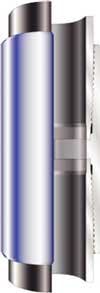Frank Hartley
Drilling & Production Editor
A new premium connection, TenarisBlue, has been designed for complex and environmentally sensitive oil and gas activities. The performance in severe conditions increases safety, lowers trouble time, and reduces risk. Additionally, a breakthrough in a dopeless connection option for enhanced environmental protection has been introduced.
A Tenaris design team developed and tested the connection at facilities in Italy, Argentina, and Japan. The connection demonstrated outstanding structural integrity and seal response following multiple high tension/compression cycles, according to the developer. The development, design and testing resulted in the following:
- Robust design with excellent structural behavior and gas sealability under combined loading conditions for reliability and safety in demanding conditions
- Dopeless option for enhanced environmental protection and an effective dope pressure control system for use when conventional doping is requested
- Easy stabbing, fast make-up and reduced galling tendency for ease of use and reduced overall costs
- Equal suitability for both carbon steel and corrosion-resistant alloy CRA materials for improved versatility in well design programs
- Availability in a wide range of tubing and casing sizes from 2-3/8 in. to 13-3/8 in.
The connection has an increased tolerance for compression, external pressure and internal pressure. Under downhole conditions, it maintains sealability, good overtorque capacity, and structural integrity after multiple high-tension/compression cycles, the company says. On the rig floor, the connection provides easy stabbing and faster makeup with fewer turns for increased efficiency and safety. The low-galling seal and threads are designed for use without dope but can be used with dry, metal-free, and standard compounds.
Applications
According to the manufacturer, the connection is suitable for both carbon steel and corrosion-resistant alloys and opens a wide range of both onshore and offshore wells for its use: high-pressure, high-temperature, extended-reach, horizontal, deepwater, sour-service, directional and steam-injection. The design incorporates unique thread geometry and makes it a candidate for casing drilling operations as well, or in areas where external compression and external tension is necessary, the company says. The seal features a sphere-cone, metal-to-metal configuration; optimized seal and taper; reduced sliding distance, and a reverse-angle torque-shoulder.
Testing
The connection has been evaluated according to ISO/FDIS 13679, "Petroleum and natural gas industries – Testing procedures for casing and tubing connections" to the most severe connection application level IV, which is intended for production and injection tubing and casing for gas service.
As described by the document, CAL IV, a full scale-testing procedure exposes the connection to cyclical test loads including internal pressure, external pressure, tension, compression, and bending. They expose the connection to extensive thermal and thermal/pressure-tension cycling incurring a cumulative exposure of about 50 hours to gas at elevated temperature of 356°F and pressure. Limit load tests to failure are conducted in all four quadrants of the axial-pressure load diagram.
The four quadrants the document refers to, are: I) Tension and Internal Pressure, II) Com-pression and Internal Pressure, III) Compression and External Pressure, and IV) Tension and External Pressure. According to the procedures, the manufacturer defines the loading points at which the connection should be tested in each quadrant, following the equations provided and the degree of accomplishment desired.
null
At least 10 loading points per quadrant are required. The conjunction of them makes what it is called the "test load envelope" or "service envelope" that defines the bounds of the combinations of loads (axial, pressure, and bending) within which the connection will maintain its structural and sealing integrity on a cyclical load basis.
The service envelope can be represented on a Von Mises graph (VME) as a percentage of the axial tensile yield strength of the connection, and it's up to the manufacturer to limit it from quadrant to quadrant. The connection has been successfully tested at 95% VME service envelope on the four quadrants, in many different sizes.







